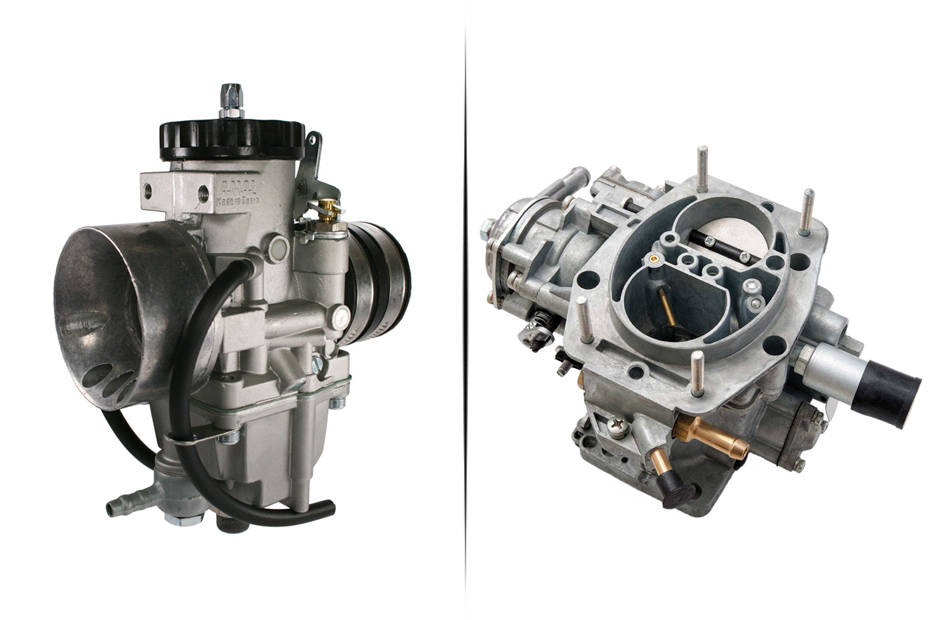Carburettor vs Fuel Injection: What’s The Difference?
Modified On Mar 31, 2019 12:39 PM By Gaurav Sadanand
- 1598 Views
Here's a closer look at how the two systems function

The age-old question of which system works better still haunts many of us. There’s the simple, purely mechanical carburettor on one side and the electronically aided, precise fuel injection system on the other. Both systems do the exact same job of feeding air/fuel mixture to the engine. Take the Gixxer SF for example. It’s offered with both carb and EFI (Electronic Fuel Injection) systems which put out slightly different power outputs and efficiency. How’s that so? And, how does a carb differ from a fuel-injection system in terms of functionality and cost? To answer these questions, we have a closer look at how the two function, their positives and negative aspects.
Carburettor:

The carb has been around for ages. Its simple framework means it’s easier and more cost effective to manufacture and maintain. In a nutshell, carbs work on a simple low-pressure vacuum. It’s essentially a pressure vacuum created in the cylinder when the piston moves from top-dead-centre to bottom-dead-centre (in the 4 stroke-cycle). As a result of this vacuum, fuel is pumped out from a reservoir through narrow jets and fed into the cylinder along with a dose of air for combustion. It’s this simplicity that made carbs the preferred choice of fuel delivery systems since the late 1800s. Carburettors are every greasemonkey’s dream. Their simple mechanical parts are easy to work with and cheap to replace.
However, since the system is purely mechanical and doesn’t rely on any electronics to monitor its inner workings, it’s affected by external factors like varying air temperatures and altitudes. For the system to work properly and more efficiently at high altitudes, it would require constant external adjustments, which means fiddling with the air and idle screws. Furthermore, the system isn’t particularly good at saving fuel in a parked bike, as the open vents on the carb’s float bowl mean the stored fuel is prone to evaporation. Then comes environmental issues, where carbs are known to underperform. An EFI system uses injectors and sensors to provide precise air-fuel-ratios, which in turn gives better fuel efficiency and produces lower carbon-based emissions. On the flipside, a carb isn’t as accurate with its air-fuel ratios, which more often than not results in improper combustion and more tailpipe emissions. Thanks to this and strict emission norms, two-wheeler manufacturers are transitioning to fuel-injection systems.
Fuel Injection:

Fuel-injection systems came into the automotive world around the 1980s and proved to be much more reliable than carbs. The system may look pretty simple from the outside but there’s a lot more than meets the eye. It’s a complex arrangement of sensors, injectors and most importantly an electronic control unit (ECU) that makes constant minor adjustments to give the cylinder the perfect mixture of air and fuel. Unlike a carb, there are no choke or external adjustment screws to work with -- and the system isn’t affected by external factors like weather temperatures and altitudes, at least in the vast majority of cases.
In fact, a fuel-injection system has the ability to create its own internal pressure which performs exceptionally well in these conditions. Even in thin air or low oxygen, the fuel-injection system is capable of working with a limited air-fuel-ratio range to provide the cylinder with enough mixture to keep it working effectively. That said, the complexity of the system restricts you from working on it with a bunch of tools, which can be done in case of a carb. It’s highly unlikely for a fuel-injection system to throw a fit; however, in the likely case that it does, the only way to fix it would be to visit the nearest company workshop - something that’s not easy to find in remote areas. Moreover, parts like a new fuel pump or throttle position sensor are expensive to replace. It’s no surprise then that there’s a substantial price difference between a fuel-injected and a carb bike. For instance, the Gixxer SF ABS carb retails at Rs 97,524 while the SFFI is priced at Rs 1.01 lakh - a premium of Rs 6,000.
So, while fuel-injection systems are better than carbs on most fronts, it does have its downsides, although they are quite negligible in comparison. Besides, the world is moving towards EFI considering ever tightening emissions norms. Only small-capacity bikes in India will remain carburetted once BSVI rolls in. And after that, it's unlikely that carbs will be able to keep up with future emissions norms.
Real-world fuel efficiency differences (as tested)

To draw a comparison between the fuel delivery systems, we’ve pulled up a few numbers from our road tests that should give you a clearer picture in terms of performance differences. The Suzuki Gixxer SF Fi, for instance, returned a much higher fuel efficiency of 51kmpl in the city and 62.47kmpl out on the highway. It was also quicker off the line and clocked a 0-60kmph time of 5.21 seconds and a 0-100 time of 17.56 seconds. On the contrary, the carb variant was slower off the line with 5.60 seconds for the 0-60kmph run and touched 100kmph in 19.71 seconds. The carb variant returned 48.54kmpl and 55.02kmpl in the city and highway respectively.
